
From
February 2011, Visit to Drew University Special Collections and Archives
Last week, I had the pleasure of taking a tour of the
United Methodist Archives and History Center (to be abbreviated as UMC Archives from here on), University Archives, and Special Collections at Drew University. Seen above are my gracious tour hosts (from left to right), Chris Anderson, Methodist Librarian and Coordinator of Special Collections; Evan Dodge, Preservation Assistant; Masato Okinaka, Library Conservator; and Matthew Beland, Acquisitions/Archives Assistant. Chris and Matthew were my guides in the UMC Archives, and Evan and Masato joined us when we moved across the street to
the main library where the Special Collections and University Archives are held.
The United Methodist Church Archives
Drew University, first founded as a seminary in 1867, has been collecting archival materials since its inception. The sizable United Methodist Archives and History Center was built in 1982, when the original seminary’s records were moved from the main library. The international archive for the United Methodist Church was moved from Lake Junaluska, N.C., to Drew not long afterward. Although most of the collection has not yet been digitized, Chris is collaborating with 12 other United Methodist seminaries to digitize select holdings from each of the theological schools that will be included in the Internet Archive.

From
February 2011, Visit to Drew University Special Collections and Archives
Although the images I snapped in the processing area of the UMC Archives are a bit grainy, they do reflect the sheer size of the place. These archives, the University Archives, and the Special Collections total nearly 10,000 linear feet.

From
February 2011, Visit to Drew University Special Collections and Archives
As soon as I walked into the processing area of the UMC Archives, I thought “What a pleasure it must be to be able to spread out and arrange large collections here.” In the photo above, you can see their processing archivist’s work on a collection of more than 100 boxes of the Bosley collection. Bosley was a 20
th century minister who collected quite a bit of material during his lifetime. Currently, theology grad students are processing the materials. This arrangement reminds me a bit of
the work I did back in the summer in Utah.

From
February 2011, Visit to Drew University Special Collections and Archives
Above is a view of the processing area from a little catwalk leading to the archives shelving. In the background, you can see two doors at different levels. One leads to the audio-visual materials vault, which houses among other things, films from the 1936 Berlin Olympic games. Mostly, it holds films from missionary excursions and Methodist television programs. The other vault holds church artifacts. Unfortunately, I did not get to see inside the vaults, but I did see quite a lot of the place, nonetheless.
The UMC Archives, Drew University Archives, and Special Collections employ 3 full-time staffers. One part-time (10 hours a week) archivist services the archives. The UMC Archives also has its own conservation space, although no one was in the space when I took the tour.

From
February 2011, Visit to Drew University Special Collections and Archives
Moving upstairs to the holdings area of the UMC Archive, I was able to see how the church’s archives were separated from the original seminary’s archives by clear labeling practices (UMC above and below, Drew following).

From
February 2011, Visit to Drew University Special Collections and Archives
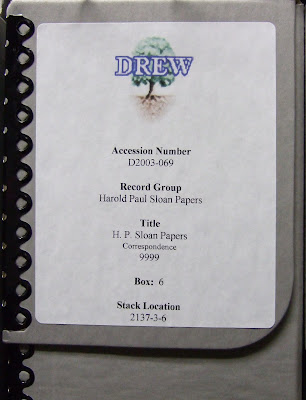
From
February 2011, Visit to Drew University Special Collections and Archives
Among the shelves also are the papers of former New Jersey Governor Tom Kean. Kean served as President of Drew University after his two terms as governor.
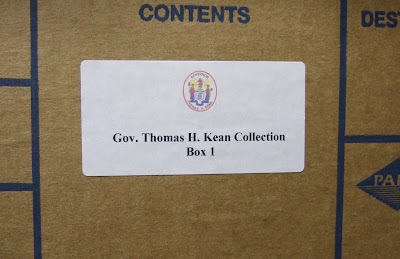 February 2011, Visit to Drew University Special Collections and Archives
February 2011, Visit to Drew University Special Collections and Archives
You might be interested to see Drew’s very nicely done
finding aid of the 125 box Kean collection (that’s 156 linear feet, for you sticklers for detail).
Along with the records, photographs (of which UMC Archives holds 250,000), films, and artifacts, visitors can find 4,000 hymnals in the Methodist Library. A miniature one is held by Chris below.

From
February 2011, Visit to Drew University Special Collections and Archives

From
February 2011, Visit to Drew University Special Collections and Archives
Recently, the archives received a large donation from the Byron Society of America, an organization devoted to Lord Byron and everything remotely related to him and his works. Below is a photo of about half of the material waiting to be processed. Drew University’s library publishes a marvelous newsletter that features the acquisition in its
Fall 2010 issue.
Visions, the newsletter, does an excellent job of describing new donations and work being done at the UMC Archives and Special Collections. If other libraries had the resources to produce such a newsletter on a regular basis and distribute it widely, they would do well by referring to
Visions as a “best practices” example.

From
February 2011, Visit to Drew University Special Collections and Archives
Most of those Byron Society boxes hold books, but the collection also includes a number of artifacts, artwork, and posters, some of them framed. In fact, when we sat in a room usually reserved for researchers, I saw a few of the framed Byron posters waiting to be preserved. The Methodists were exceedingly good record keepers, as can be seen by the Archives’ collections of annual conference reports. Some of these documents date back to the 1770s. As we walked along, Chris pointed out shelves of missionary minutes from Methodists of all stripes.
The Western Christian Advocate from 1851 is shown below.

From
February 2011, Visit to Drew University Special Collections and Archives
Here is a very short video of Chris describing
The Western Christian Advocate and its relationship to larger newspapers.
One of the other large collections at the UMC Archives is the pamphlet collection. The archives hold approximately 20,000 pamphlets, some dating back to the 18
th century. Chris compiled
a 1,200 page bibliography on the collection and put it online. Once researchers had access, he received emails daily from researchers around the world requesting information about the pamphlets. Below are just three examples of pamphlets in the collection.

From
February 2011, Visit to Drew University Special Collections and Archives
Drew’s archivists have a three-step process for the pamphlets: 1. Identification, 2. Conservation, and 3. Digitization. Currently, they are in the identification phase, so these will rest in acid-free paper until they can have their staples removed and be placed in pamphlet covers (see
Preservation Department later in this story).

From
February 2011, Visit to Drew University Special Collections and Archives

From
February 2011, Visit to Drew University Special Collections and Archives
Some of the materials in the archives’ holdings become stars for a little while when they make it to the exhibit space where visitors enter the building. Underneath that space is a tunnel that connects the building to the library next door. It was used to transport some collections during inclement weather. Below is a photo I took of the exhibit space. Because February has just ended, they are preparing for a new exhibit to replace the one below on African American Methodist history. In the fall, the UMC Archives will be displaying an exhibit on Methodism and the American Civil War to commemorate the 150
th anniversary of the beginning of the Civil War.

From
February 2011, Visit to Drew University Special Collections and Archives
In the background of the exhibit space, you can see the reading room where scholars from around the world, authors, students, local historians, and genealogists use the archives’ holdings to do their work. Currently, the archivists see between seven and ten patrons per week. At the moment, they aren’t hosting any long-term researchers. However, a researcher from Chile recently spent five days at the facility working on a book about South American Methodism and visual culture.
Some of the fun things to see in the library I did not photograph, unfortunately, but I encourage you to go see them. For instance, how often do you get to see a death mask in a library (or anywhere else for that matter)? John Wesley’s (founder of the Methodists), is displayed upstairs in a glass case, not far from a reliquary supposedly holding British colonial evangelist George Whitfield’s thumb. In a room off the reading room, you also can see many, many ceramic busts of Wesley (also encased in glass).
Speaking of exhibits, when we walked next door to the library (where Matthew took over as primary tour host), I had the chance to see a little of the graphic art novel exhibit in the lobby. Also in the lobby, floating above the entryway is the gorgeous
Rose Window from the original Cornell Library.

From
February 2011, Visit to Drew University Special Collections and Archives
During my tour of Special Collections, Matthew showed me some photographs of the Rose Window in its original setting. The photo below has been preserved in a polyester sleeve, hence the milky glare (sorry!), but you can still see the round window at the end of that glorious library.

From
February 2011, Visit to Drew University Special Collections and Archives
Preservation Department
After winding our way through the library, we reached the Preservation Department, where Masato and Evan met us. Masato showed us his latest project, making an enclosure for a small addition to the Willa Cather collection (below).

From
February 2011, Visit to Drew University Special Collections and Archives
He had folded sheets of archival paper around some of the pieces to prevent them from becoming acidic.

From
February 2011, Visit to Drew University Special Collections and Archives
Remember the pamphlets? Masato’s enclosure below is an example of what a pamphlet cover looks like.
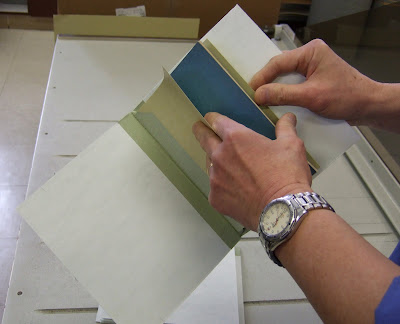
From
February 2011, Visit to Drew University Special Collections and Archives
University Archives and Special Collections
After Preservation, we moved on to the University Archives, “a labor of love” for Matthew. He gets to spend 10 hours a week on the archives started in the early 1970s by Rae Jones, the wife of former Library Director Art Jones. Although Drew had been collecting for the previous 100 years, there is a bit of a murky line between where the University Archives starts and where the seminary records end. Fortunately for all involved, there is an effort to house all the archives under one roof.
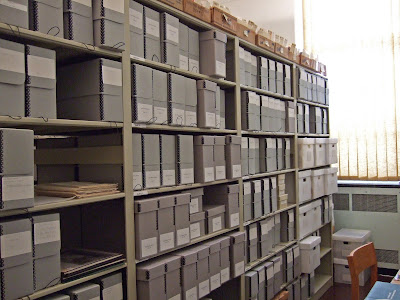
From
February 2011, Visit to Drew University Special Collections and Archives
In the University Archives area, the holdings include the
Drew University Bulletin, student dissertations, and the
Drew Acorn, one of Chris’ favorites because it provides snapshots of the campus over the past 50 years. Also found in University Archives are many architectural records of the school’s buildings, the George D. Kelsey Papers, and the Gibbons Family Papers. Kelsey was Martin Luther King, Jr.’s mentor at Morehouse College, and later became Professor of Christian Ethics at Drew University. William Gibbons owned the land on which university now stands; his father Thomas won the U.S. Supreme Court case “Gibbons vs. Ogden” in 1824.
One of the most-used records in the University Archives is the Matriculation Book for the Drew Theological Seminary. Below is a short video of Matthew describing its importance to the school and its students.
This is a close-up view of the Matriculation Book’s opening page.
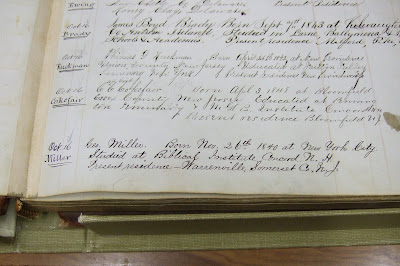
From
February 2011, Visit to Drew University Special Collections and Archives
Matthew’s current work includes gathering photos for Drew publications and the theological School in preparation for the upcoming theological dean installation.
Among the Special Collections at Drew are the Bela Kornitzer and the Georges Simenon Collections. Kornitzer’s papers and photographs of him with luminaries of the highest stature fill
a room (below).

From
February 2011, Visit to Drew University Special Collections and Archives
Kornitzer spent his time interviewing and corresponding with very famous men for the purpose of documenting their relationships with their fathers. Records of his experiences collecting this information exists in cassette tapes, phonodiscs, paper-based records, photographs, and ephemera. The Simenon collection also has its own space, filled with first editions of the author’s works in French and English, notebooks, and assorted ephemera.
There are many intriguing treasures in Drew University’s Special Collections and Archives. A researcher could easily spend months at the UMC Archives, depending on his or her historical bent. Best of all, the folks who keep it running smoothly are very knowledgeable, quick with a smile, and love what they do.
They encourage researchers to use their online finding aids (Drew University Special Collections and University Archives website:
http://www.drew.edu/depts/library.aspx?id=292 and/or UMC Archives web site:
http://www.drew.edu/depts/library.aspx?id=45889). Donors who wish to give their personal collections to Drew University may contact Chris or Matthew at the information below.
Contact information
Interested users and donors should contact
Christopher J. Anderson
Methodist Librarian and Coordinator of Special Collections
Drew University
36 Madison Avenue
Madison, New Jersey 07940
http://www.drew.edu/depts/library.aspx?id=208
cjanders@drew.edu
973-408-3910
Or
Matthew Beland
Acquisitions and Archives Assistant
Same address as above.
mbeland@drew.edu
973-408-3532

























